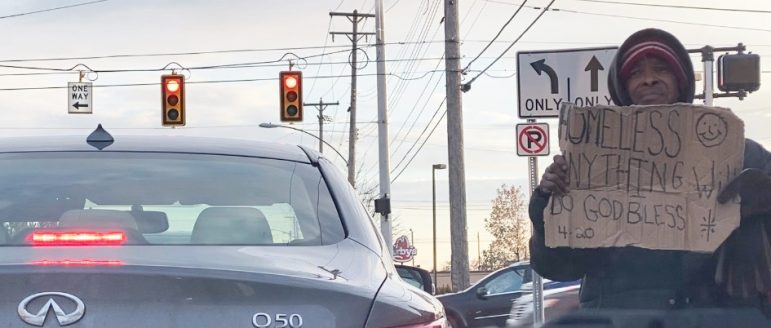A man stands on the edge of Saginaw Highway, just before the on-ramp to U.S. 127. A dog sits at his side.
He holds a cardboard sign asking for food, money or prayers.
That’s what many people think homelessness looks like, area advocates and experts say. But the issue is much more complex and impacts a diverse segment of men, women and children.
“Homelessness doesn’t discriminate,” said Laura Leblanc, the director of development and communications for Volunteers of America in Lansing. The nonprofit organization provides affordable housing and other services primarily to low-income people throughout the United States.
Scope of the problem
In Michigan, there were 58,046 people who were literally homeless in 2018 and 6,235 who were chronically homeless, according to a state report about homelessness in Michigan.
Literal homelessness is anyone without a fixed, regular and adequate place to sleep at night. The chronically homeless are those who have experienced homelessness for at least a year, or on and off while struggling with any sort of disability including mental illness, substance abuse or physical disabilities.
According to the 2018 report, throughout Clinton, Eaton and Ingham counties, there are about 5,058 people who are homeless, or about 8% of the local population. This number does not include those who are experiencing other variations of homelessness including couch-surfing or those in and out of homelessness.
Causes of homelessness
“In terms of homelessness, typically if someone is unstable and loses a job, or their car breaks down, it can quickly cause someone to go off their feet,” Leblanc said.
Laura Grimwood, director of communications at City Rescue Mission of Lansing, said homelessness is a complicated issue and people can experience it in radically different ways. City Rescue Mission provides food, shelter and other services to women, children and men in need in Michigan’s capital area.
“About 80% of those who are homeless are not the stereotypical homeless person,” Grimwood said. “They are people who need a little help and encouragement and information as they work to transition out of homelessness.
“The remaining 20% are those who truly struggle with obstacles, such as mental illness, addiction and cognitive decline.”
Diverse challenges
There are many different factors that affect homelessness, and the situation may not be the fault of the person who is homeless. Melina Brann, executive director at the Women’s Center of Greater Lansing, said homelessness is a systemic problem. It can be caused by a lack of affordable housing, poverty, domestic violence, a lack of affordable health care or inconsistent care for mental illness or addiction, among other reasons.

The annual report also said that of those who are literally homeless, 18% are under 18 and 10% are between 18 and 24.
“The truth is that homelessness impacts people with doctorate degrees, people who have never finished school, people coming from middle-class families as well as those born into poverty,” the City Rescue Mission’s Grimwood said.
Children suffer from homelessness as well.
“People need to understand that the average age of homelessness is 9,” said Susan Cancro, the executive director of Advent House. Advent House offers a host of services and programs designed to help the homeless and impoverished in the community succeed and thrive.
Advocates for the homeless say that family homelessness is increasing. On average, it took 56 days for a family who became homeless in 2018 to be successfully housed.
“We’re seeing a lot of single dads with their children, which is a little bit abnormal from what we’ve seen in the past,” said Tracie Baise, the shelter director for the Homeless Angels’ Lansing campus. “Also, individuals male and female over 55.”
Homeless Angels is a Christian street-based ministry with a mission.
How to help
Volunteers of America’s Leblanc said increased public awareness, donations and volunteering efforts are needed to improve the issue. In addition to cash donation, she said many organizations that help the homeless need donated items such as blankets, pillows and personal hygiene products.
“I really want to make sure that (the public is) reaching out to those in need of it most,” Leblanc said. “We are always in need.”
The Lansing area has already experienced its first snowfall of the winter season. Colder temperatures can cause problems as shelters hit capacity.
“I think winter is extremely difficult because it’s so much harder to be homeless in the cold, especially since we’ve already had snow so early,” Leblanc said. “It makes it really difficult for the homeless and very tough to stay outside, so it’s really important to find access to resources.”
Baise at Homeless Angels said offering help in a variety of little ways can make a big difference.
“Sponsoring dinner, whether it’s in the park or one of our (Homeless Angels) locations. A diaper drive, can drives, that kind of thing is huge because we help bridge the gap in the community,” Baise said.
She also said mentoring and tutoring help is needed because of the number of kids in the facility. Sitting at the shelter for shelter supervision and volunteering for craft and game days are also ways that volunteers and community members can help.
Grimwood said it’s important to understand in what areas local organizations need help — and be willing to help there.
“Oftentimes, people say I want to do this, and they can even get upset with a nonprofit who can’t accommodate their want,” Grimwood said. “When a volunteer says, ‘I am willing to do anything: wash dishes, clean toilets…’ it really encourages us, because these are things that are truly sacrificial and show a real heart of compassion for someone in need.”